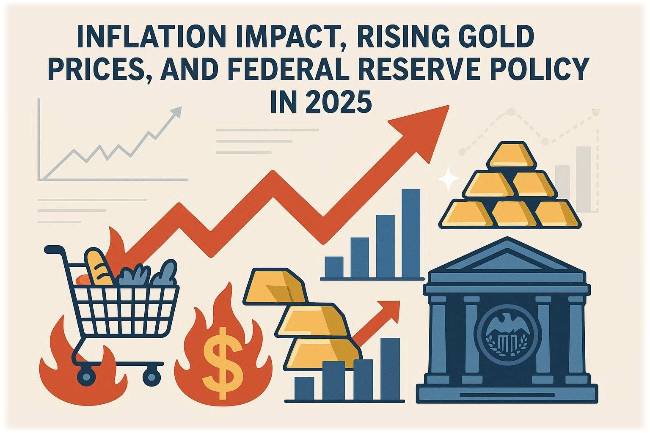Inflation Reality Hits Hard, Gold Prices Soar
Disclaimer: This content is for informational purposes only and does not constitute financial or investment advice. Consult a qualified professional for personalized guidance tailored to your situation.
By Doug Young – 07 October 2025
Introduction
Inflation remains a persistent challenge in the United States through 2025, despite various policy interventions.
The continuing rise in consumer prices has corresponded with a notable surge in gold prices, reflecting broader market responses to economic uncertainty.
This news item examines recent inflation trends, their impacts on consumers and retirees, the role of gold amid these conditions, and the economic policy context shaping the current environment.
Understanding Inflation Trends in 2025
Current Inflation Statistics
As of August 2025, the U.S. Consumer Price Index (CPI) reported a headline inflation rate of approximately 2.9%, marking the highest increase since earlier this year.
Core inflation, which excludes food and energy prices due to their volatility, remains elevated at roughly 3.1%.
These figures highlight sustained upward pressure on consumer goods and services, underscoring inflation’s ongoing presence in the economy.
Factors Driving Inflation
Several factors contribute to the current inflationary environment.
- Tariffs imposed on imports have elevated prices on various goods such as clothing and transportation-related products.
- Gasoline prices have also experienced volatility, frequently impacting the overall cost of living.
- Supermarket food prices continue their upward trajectory.
While rents have seen some easing recently, this has not been sufficient to offset inflationary pressures across other essential categories.
Federal Reserve’s Policy Response
The Federal Reserve responded to inflation concerns with a set of rate cuts during its September 2025 meeting, reducing the federal funds target range to 4.00%–4.25%. The Fed also projected additional rate reductions before the end of 2025 and into 2026.
Despite these moves, inflation has remained above the Federal Reserve’s longer-term goal of 2%, suggesting ongoing challenges in moderating price increases. The central bank’s future decisions will continue to balance inflation control with broader economic growth objectives.
How Inflation Affects Consumers and Retirees
Erosion of Purchasing Power
Inflation diminishes the purchasing power of the dollar, meaning consumers must spend more to acquire the same goods and services. For example, items such as groceries, gasoline, and healthcare have become noticeably more expensive over the past several years.
This decline in purchasing power can significantly affect household budgets, especially for those on fixed incomes.
Differential Impact on Income Groups
Inflation’s impact is uneven across the population.
Lower-income households typically allocate a larger share of their income to essentials that are subject to inflation, such as food and housing, making them more vulnerable to rising costs.
Conversely, higher-income groups may benefit from assets or income streams less sensitive to inflation.
Social Security benefits and some pensions include cost-of-living adjustments (COLAs) to partially offset inflation, but many fixed-income retirements do not.
Challenges for Retirees’ Financial Planning
For retirees, inflation presents a unique challenge. Those dependent on fixed pensions or savings that do not adjust with inflation risk seeing a gradual erosion of their living standards.
Understanding and planning for inflation’s long-term effects is critical for sustaining financial security in retirement.
The Role of Gold in the Context of Inflation
Historical Relationship Between Gold and Inflation
Historically, gold has been viewed as a store of value during periods of currency weakness and inflation. As the purchasing power of fiat currencies diminishes, investors and consumers often turn to tangible assets like gold to preserve wealth.
This trend is well-documented and continues to influence market dynamics.
Gold Price Developments in 2025
In 2025, gold prices have been on the rise, with prices reaching near record highs approaching $4,000 per ounce in early October. This surge has been driven by a combination of sustained inflation, Federal Reserve monetary policy actions, and uncertainty in global economic and geopolitical conditions.
Market fluctuations reflect the complex interplay of these factors rather than a singular cause.
Comparison With Other Asset Classes
Gold’s performance during inflationary periods often contrasts with stock and bond markets, which can exhibit increased volatility. While stocks may struggle in environments of rising costs, gold frequently gains appeal as a diversified asset class.
It is important to note that this discussion is informational and not an endorsement or advice on investment decisions.
Broader Economic and Policy Context
Tariffs and Trade Impact on Inflation
Recent tariffs imposed on a range of imported goods have contributed directly to inflation by increasing costs for consumers. Tariffs particularly affect categories like clothing, electronics, and transportation-related products, leading to broader price increases across the economy.
Trade policies continue to influence inflation alongside domestic supply and demand factors.
Federal Reserve’s Long-term Inflation Targets
The Federal Reserve maintains a long-term inflation target of approximately 2%. Achieving and sustaining this target has proven challenging through 2025, given ongoing economic disruptions and shifting market conditions.
Future policy adjustments will aim to realign inflation with this goal while supporting economic growth.
Outlook for Inflation and Interest Rates
Economic forecasts project moderate growth and a gradual easing of inflation over the next several years.
Market participants and policymakers, however, remain vigilant to risks including potential new supply chain disruptions or shifts in consumer demand that could alter this trajectory.
Summary and Key Takeaways
Inflation remains a significant economic factor shaping consumer costs and market responses in 2025.
The U.S. continues to experience inflation rates above the Federal Reserve’s 2% target, driven by diverse factors including tariffs, energy prices, and supply constraints. This environment reduces the purchasing power of the dollar, with pronounced effects on consumers and retirees managing fixed incomes.
Gold prices have responded by reaching elevated levels, reflecting broader economic uncertainty and historical patterns of asset valuation during inflation.
These developments underscore the importance of closely monitoring inflation indicators and economic policy outcomes.
Disclaimer: This content is for informational purposes only and does not constitute financial or investment advice. Consult a qualified professional for personalized guidance tailored to your situation.









